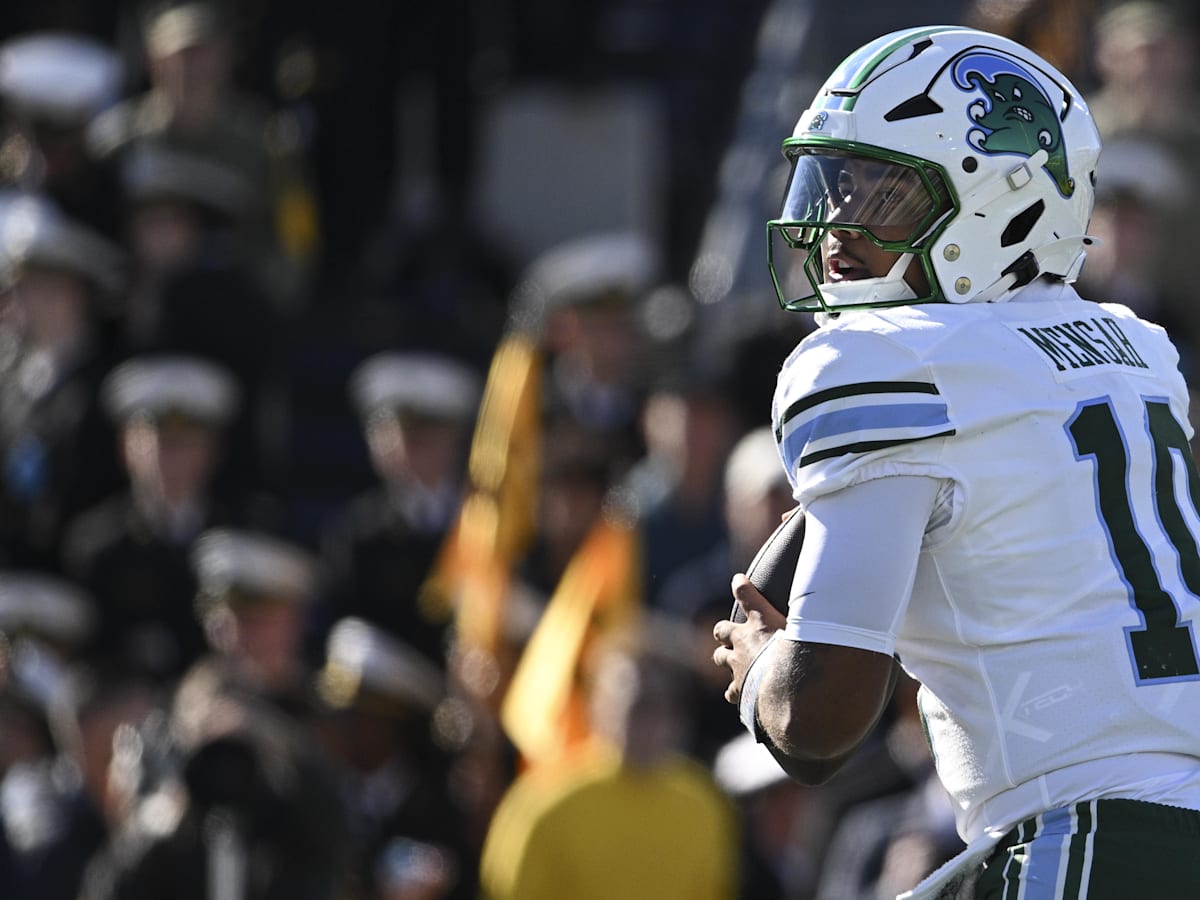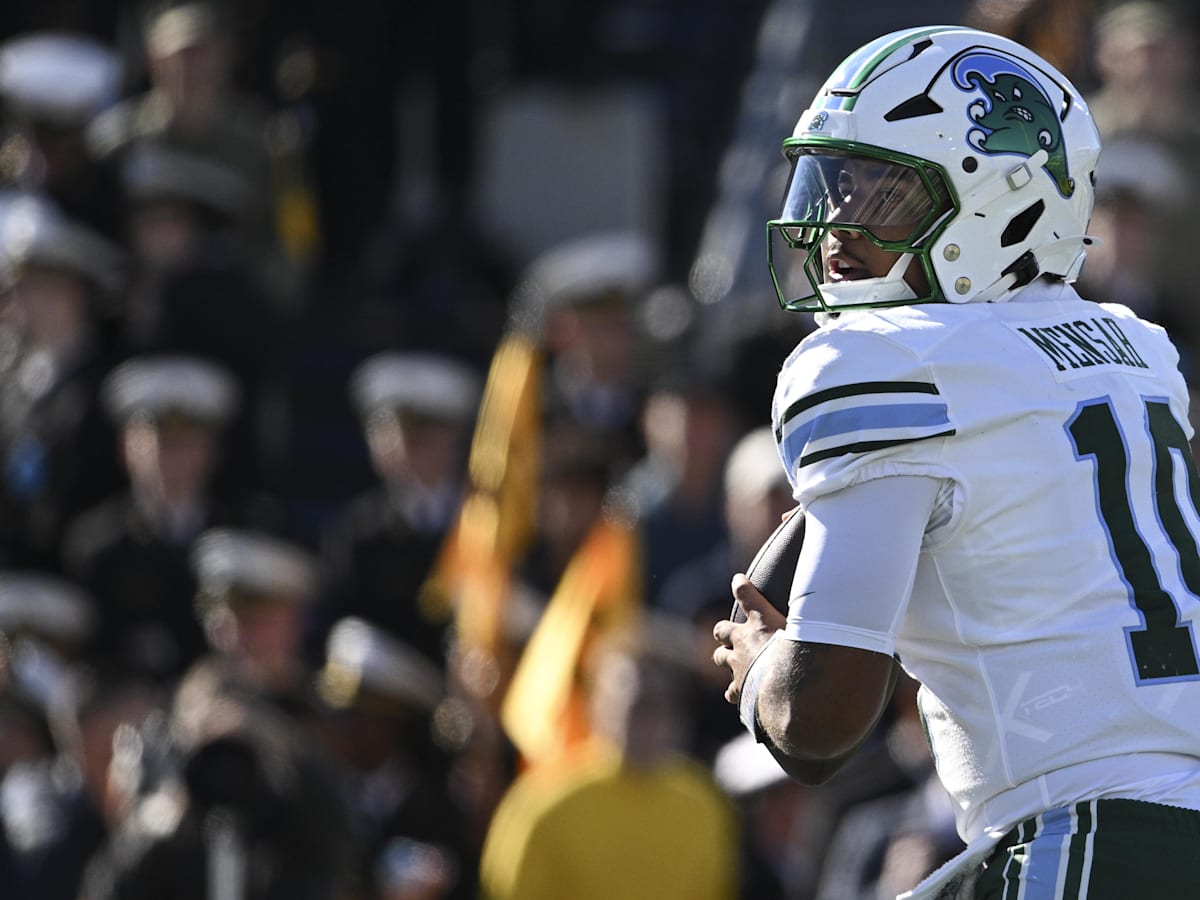NIL
Quarterback Dads give college football coaches nightmares like never before, but there’s hope
Be like Jay Underwood, Quarterback Dads. The father of Michigan super freshman Bryce Underwood is one of the good ones. There are good ones despite the constant barrage of headlines about Quarterback Dads gone wild — Carl Williams (Caleb’s dad) torching his son’s employer publicly, Nic Iamaleava (Nico’s dad) bungling a good situation at Tennessee, […]
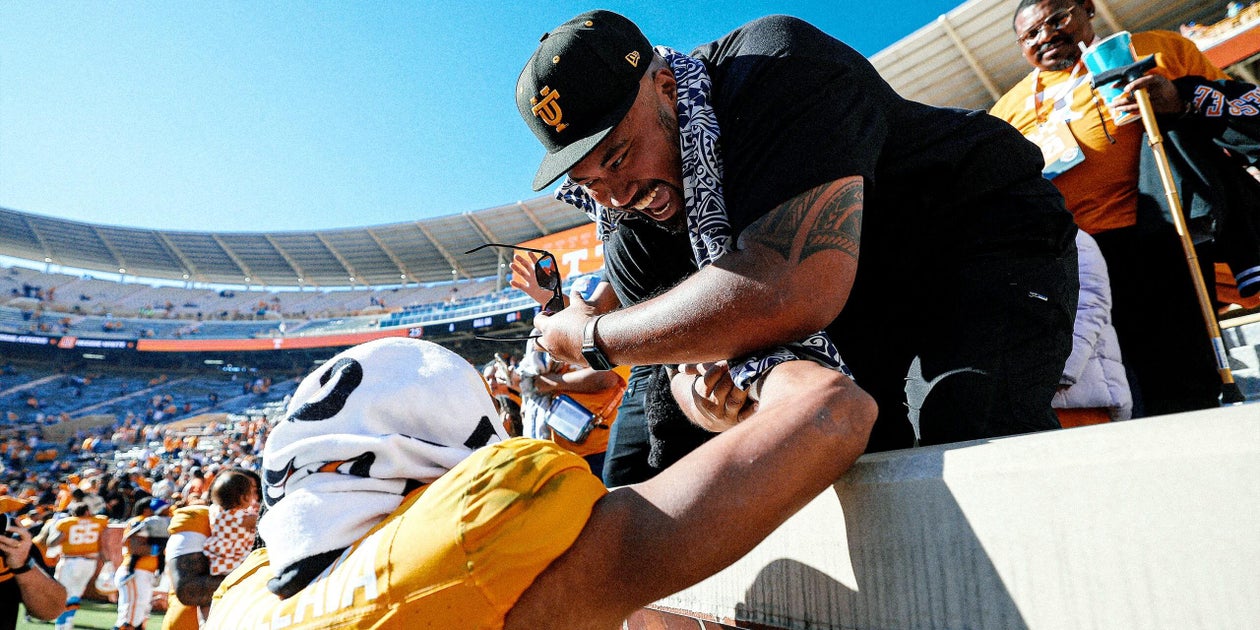
Be like Jay Underwood, Quarterback Dads.
The father of Michigan super freshman Bryce Underwood is one of the good ones. There are good ones despite the constant barrage of headlines about Quarterback Dads gone wild — Carl Williams (Caleb’s dad) torching his son’s employer publicly, Nic Iamaleava (Nico’s dad) bungling a good situation at Tennessee, Deion Sanders (Shedeur’s dad) doing whatever he did to contribute to a fringe NFL first-round talent going in the fifth round, and so on.
Those are three success stories at the glamor position of American sports, of course, which means some parental credit must be due. But some of the behaviors match that of countless Quarterback Dads whose sons’ names aren’t known, whose misdirected ambition and absence of perspective make them college football outlaws of sorts.
“Quarterback Dad” is generally not a compliment among the college coaches I talked to for this piece, some of whom have stopped recruiting quarterbacks who checked every box except: Can we tolerate his dad?
“We’re picking the dad almost as much as we’re picking the quarterback,” said a Power 4 head coach, who was granted anonymity, like others in this story, so he could speak freely on the subject. “Every person in this business has horror stories.”
The explosion of money in the game in the past few years has made things only more toxic. But I’m here to tell you there’s hope.
There’s hope, in part because, at some point, college athletics will become less chaotic. That’s probably going to require collective bargaining at some point. But it will happen, and it means player movement will slow down and compensation will be fairly determined by professionals. Less chaos in college football should mean less chaos among its various factions.
Also, at least there’s awareness of the Quarterback Dad dynamic. We’re talking about it. People are trying to make things better, including the guy who wrote the actual book on Quarterback Dads, the guy who presents Jay Underwood as a “how-to” of sorts for those with pigskin-slinging children.
Donovan Dooley is a prominent quarterbacks coach who counts Bryce Underwood among his clients, has worked with the family for years and noted in that 2022 book (written with sportswriter Teddy Greenstein and aptly titled “Quarterback Dads: Wild Tales from the Field”) that Jay had previously been “the classic Quarterback Dad, in every maddening sense.”
This included Jay’s proclamation, when Bryce was closer to elementary school than graduation, that he could “be the LeBron James of football.” Invoking the (arguable) GOAT of another sport is a classic sign of the Not-In-Touch-With-Reality Dad, and Jay’s admitted overzealousness in critiquing his son screamed Helicopter Dad. These are two of the 12 types of problematic Quarterback Dads detailed by Dooley (he lists three good types).

Bryce Underwood’s dad, Jay, has remained largely in the background and allowed his son to enjoy the spotlight of being the No. 1 recruit in the nation. (Mike Mulholland / Getty Images)
It all changed when Jay, with Dooley’s help, realized how strained his relationship with his son was getting. To save it, he needed to revert to being just a dad and take the pressure off his son.
“Total turnaround,” Dooley, whose Quarterback University is based in Detroit, said last week. “Now, Jay stays in the background a lot. Hell, I don’t even know if some of the staff at Michigan know him. It’s usually not that way when your son is a prime guy like this, but he sits back and lets Bryce do his thing.”
To that point, Underwood could not be reached to speak on the topic.
This is the kind of reform Dooley seeks to foster. Not that he’s seen enough of it. The urge to help goes back to his Detroit childhood as a future high school and college quarterback, dealing with a father he described as “crazy as hell” when it came to pushing him in football.
The book inspired an outpouring of letters and emails, Dooley said, from fathers who apologized for their behavior and from both mothers and fathers who thanked him for forcing moments of clarity with his storytelling.
But Greenstein and Dooley wrote it in the early days of the dirtiest phrase in college football coaching: “NIL and the transfer portal.” For folks in that profession, NIL, the transfer portal and the Quarterback Dad make up the unofficial unholy trinity of the sport.
“It’s heightened the anxiety around everything,” Dooley said of Quarterback Dads now having seven-figure paydays as incentive and free movement as leverage. “I mean, you’ve got dads, not long after kids get out of the womb, kids that are 5 years old, coming up with logos and slogans for social media to get attention. You’ve got dads talking dollar amount with coaches before they ever talk football or academics.”
How bad is it for some? One Power 4 coach contacted for an interview on Quarterback Dads replied: “Nah. I’m staying away from that.”
A Group of 5 head coach said he loved the topic and that it should be made into a documentary, but was fearful of telling any specific stories because “if it ever got back to me, I’d never get a quarterback again, ever.”
He did explain the difference between dealing with problematic Quarterback Dads now and five years ago.
“A dad texts, ‘Why aren’t we doing more quick game with my son? Why so much dropback game?’ S— like that,” the coach said. “Back before the portal, you text back something like, ‘Man, let’s sit down after the season and talk about this if you feel that way.’ Now? You pick up the phone immediately and talk through it. You explain why you’re doing what you’re doing, in detail.”
This isn’t necessarily all bad, the coach said, because “we really should be giving our kids more ‘whys’ in today’s game and we should be thinking about it collaboratively.”
It’s just harder to be collaborative with someone who, unlike the quarterback in question, doesn’t play the game and doesn’t know the concepts or what it takes to execute them. This can be the mark of The “We” Dad in Dooley’s book (the dad who thinks he’s also part of the team), The Stat-Hungry Dad or The Really-Not-In-Touch-With-Reality Dad. Or all three.
“Some of them, the wild, wild ones, are all 12,” Dooley said of categories that also include The Reminiscer, The Jealous Dad and The Braggin’ Dad. “Those are the ones who read the book and say, ‘I’m none of those.’ I’m like, ‘Dude, you’re all of those.’ ”
Dooley got to know the Iamaleavas on the recruiting circuit and considers Nic Iamaleava (who did not respond to a request for comment) a friend. He also considers him a cautionary tale.
As a Group of 5 assistant coach said about Nico Iamaleava’s abrupt departure from Tennessee amid reported financial conflict: “The kid’s in a perfect offensive system for him, he’s paid $2 million a year, even as a freshman to not play and redshirt, and you leave that for UCLA? That’s not the kid, that’s the people around him.”
As an outspoken expert on the topic, Dooley has also become a resource for college coaches in the past few years. This is not unlike college coaches who give frank assessments of their former players’ personalities for interested NFL personnel people. In this case, coaches hit up Dooley on what he’s observed and/or heard about various Quarterback Dads.
“I’m never going to say anything too negative,” Dooley said. “My code word is, ‘Yeah, that dad is wired a little different.’ That’s my polite way of saying, ‘S—, be ready for everything you don’t want.’”
What they want is what we all should want, which is for parents to not make life more difficult for their children by mangling experiences that should be positive and enriching.
If you’re like me and you’ve spent a lot of years as a parent around a lot of different sports, you’ve seen some ridiculous behavior from alleged adults. Economics, both in terms of the cost of higher education and the rewards possible for the tiny fraction of a fraction of elite athletes, dictates some of this.
It does not excuse completely missing the point of what both sports and parents are supposed to be.
“Sport is sacred,” Vanderbilt coach Clark Lea said. “It’s sacred because it’s a vessel of self-discovery. You learn to belong to yourself, so you can belong to something bigger. Sport is a place of belonging and community where you can gather a large body of people around one mission. That’s special, that’s sacred, but sports culture is sick right now.
“And you can experience that at any level of competition. There are a lot of parents who are focused on the performance of a child rather than the development of a child.”
This is not new.
I’ll keep unnamed the Quarterback Dad who used to call me frequently about 20 years ago, once assuring me the very bad team I covered had as much talent as Pete Carroll’s national champion USC Trojans and was poorly coached — that was very untrue, and he was very inebriated.
The late Marv Marinovich remains the standard of Quarterback Dad dysfunction, as first revealed in the 1988 Sports Illustrated story “Bred to be a Superstar” by Doug Looney about Marv’s QB son, Todd Marinovich. Marv used Eastern Bloc training methods to build him into a passing machine and essentially hijacked his childhood. Todd was a star recruit prohibited from eating fast food, a USC quarterback arrested for cocaine possession, a failed pro and now a dad speaking out on the right way to nurture kids in sports.
Plenty of Quarterback Dads care about that. Some of them fall into Dooley’s good categories — The Helpful Dad, The Hands-Off Dad, The Coach Dad. Archie Manning, who has said the 1988 SI story on Marinovich spooked him into taking special care with his boys, falls into all three.
So does Dave Henigan, said Memphis coach Ryan Silverfield. Henigan is the head coach at Ryan High School in Denton, Texas. His son Seth just wrapped up four years of starting for the Tigers. Opportunities to leave and make more money emerged. Conversations about fair compensation happened, as they should.
Development, relationships and happiness prevailed. Seth threw for more than 14,000 yards, and now he’s with the Jacksonville Jaguars as an undrafted free agent.
“Stability should matter,” Silverfield said. “And transparency. A huge part of this whole thing is both sides being transparent with each other.”
Sometimes that still results in a change in environment, and sometimes that’s the right choice. I wanted to interview one of the most impressive Quarterback Dads I’ve encountered for this story, in part because I can see how his son’s movement — a fourth school in four years starting this fall — could give a completely false impression of their outlook.
Mike Wright, now at East Carolina, just wants a chance to play after coming up short at Northwestern, Mississippi State and Vanderbilt. Big Mike Wright just wanted to support his son. Tragically, Big Mike passed away recently at age 49.
“He was an example of a dad who always functioned in support of his son, not his football player, you know what I mean?” Lea said.
“My father never played football, but he loved his kids,” Mike Wright said of an engineer who tutored athletes while a student at the University of Tennessee. “Whatever we loved to do, we made it his passion.”
I did a story on the Wrights, a delightful family of six, in 2022 before Wright embarked on his starting opportunity at Vanderbilt. I went back through the notes last week and found some Big Mike Wright quotes that didn’t make the story.
He said: “I tell my kids, ‘Put your phones down, don’t listen to the noise, don’t listen to the chatter. Have fun and play football and don’t stress out too much.’ ”
He said: “Your life is an interview and everyone around you is the interview panel. So first of all, stay humble.”
He said: “Even in high school, Mike went through adversity and it wasn’t easy. At one point, I texted his coach and said, ‘I really appreciate you, because you’re making him earn everything.’”
Hey, Quarterback Dads: Be like Big Mike.
(Top photo of Nico and Nic Iamaleava: Donald Page / Getty Images)
NIL
Happy Hour: Kurtiss Riggs takes us inside NIL, top HS prospects, SDSU local freshmen, and more – Sioux Falls Live
It’s a Monday and Mid-June, over two months before actual football games start, and you’re starving for new deep-diving local college and prep football content. We have the freshest insight from the ultimate “insider” ready for you! Enjoy a smorgasbord of meaty information and educated opinions on the hottest topics from Kurtiss Riggs, our Happy […]
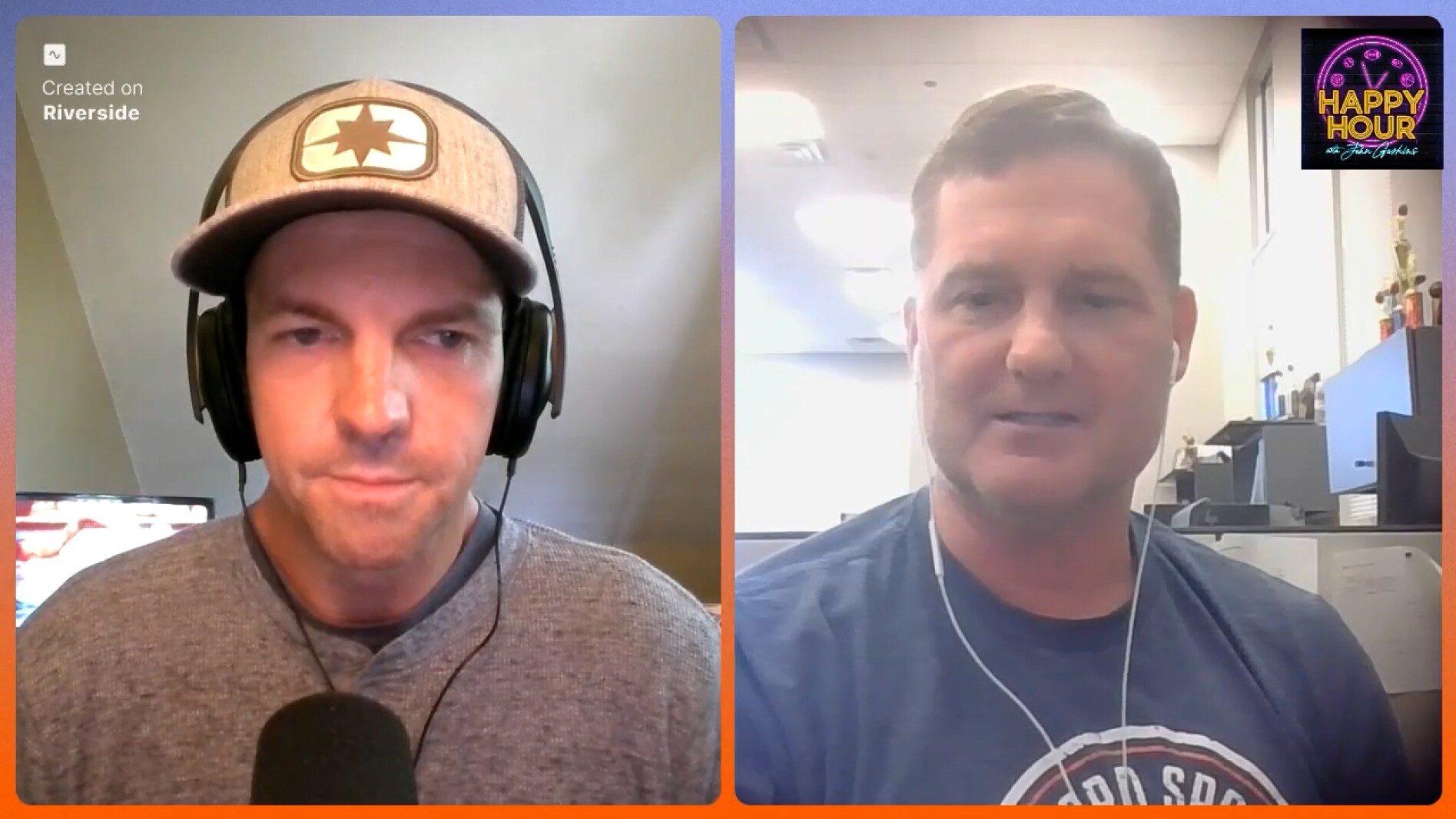
It’s a Monday and Mid-June, over two months before actual football games start, and you’re starving for new deep-diving local college and prep football content.
We have the freshest insight from the ultimate “insider” ready for you!
Enjoy a smorgasbord of meaty information and educated opinions on the hottest topics from Kurtiss Riggs, our Happy Hour with John Gaskins lead football analyst, the Sanford Sports Academy football director, veteran high school and college TV game commentator, and 11-time league champion former head coach of the Sioux Falls Storm.
Topics covered:
- What chances will SDSU fans see the top two local true freshmen — receiver Landon Dulaney (Brandon Valley) and offensive lineman Lincoln Semchenko (SF Christian) — on the field and making plays right away?
- For SDSU and USD, what are the advantages and disadvantages of “opting in” to sharing revenue with athletes (and therefore having NIL money regulated) for the first time, a result of the recently-approved NCAA-House Settlement?
- What are some things about NIL most people don’t know — the effects it has already had on coaches and locker rooms at all levels, where most of the NIL money at schools like SDSU and USD is going, and how some local players left a lot of money on the table?
- Who are the top three 2026 prospects in this region right now? We’re talking Power Four offers and commitments and possible different makers at the highest level of college football.
- What would it take for the Sioux Falls Storm to return to the field in 2026, and what do we make of last week’s resignation of head coach and long-time Storm staple Andre Fields?
Kurtiss Riggs takes us inside NIL, top HS prospects, SDSU local freshmen, “opt-in” pros/cons, SF Storm’s future
Mon Jun 16 13:13:00 EDT 2025
We have the freshest insight from the ultimate “insider” ready for you!
Enjoy a smorgasbord of meaty information and educated opinions on the hottest topics from Kurtiss Riggs, our Happy Hour with John Gaskins lead football analyst, the Sanford Sports Academy football director, veteran high school and college TV game commentator, and 11-time league champion former head coach of the Sioux Falls Storm.
Topics covered:
- What chances will SDSU fans see the top two local true freshmen — receiver Landon Dulaney (Brandon Valley) and offensive lineman Lincoln Semchenko (SF Christian) — on the field and making plays right away?
- For SDSU and USD, what are the advantages and disadvantages of “opting in” to sharing revenue with athletes (and therefore having NIL money regulated) for the first time, a result of the recently-approved NCAA-House Settlement?
- What are some things about NIL most people don’t know — the effects it has already had on coaches and locker rooms at all levels, where most of the NIL money at schools like SDSU and USD are going, and how have some local players left a lot of money on the table?
- Who are the top three 2026 prospects in this region right now? We’re talking Power Four offers and commitments and possible different makers at the highest level of college football.
- What would it take for the Sioux Falls Storm to return to the field in 2026, and what do we make of last week’s resignation of head coach and long-time Storm staple Andre Fields?
John Gaskins hosts “Happy Hour with John Gaskins,” a sports talk show for Sioux Falls and beyond that blends entertaining commentary and conversations.
NIL
Alexi Lalas blames U.S. Soccer’s struggles on ‘diversity’
Alexi Lalas recently blamed the U.S. Men Soccer’s struggles on “diversity,” following some disappointing games of late. The former Rutgers and Team USA standout chalked it up to 11 men representing the United States and all being on the same page is going to be difficult. It’s certainly an interesting reason as to why the […]

Alexi Lalas recently blamed the U.S. Men Soccer’s struggles on “diversity,” following some disappointing games of late. The former Rutgers and Team USA standout chalked it up to 11 men representing the United States and all being on the same page is going to be difficult.
It’s certainly an interesting reason as to why the men’s team is struggling right now, at least according to Lalas. He argued being “exclusive” rather than “inclusive” would be key to the U.S’s success in the future.
With just a year to go before the FIFA World Cup is held on American, as well as Canadian and Mexican, soil, some fans are panicking. That was after a 4-0 loss to Switzerland ahead of the CONCACAF Gold Cup, which the USA won 5-0 over Trinidad and Tobago in the opening group stage game.
“We oftentimes talk about our diversity and we talk about it in the fact that it is one of the advantages we have, and of the great things about our country,” Lalas said on First Things First. “But with that diversity comes diversity of thought. If I go and ask a hundred soccer people out there, ‘What’s beautiful soccer?’ I’m going to get a hundred different answers. And it might be based on ethnicity, where you grew up, even geography. All of these different things.
“So I’ve argued that the homogenous nature of some other countries and cultures just in population in terms of size are much more manageable. And there is a collective understanding and, more importantly, an agreement in this is how we’re going to play. But getting 11 men to represent this great country of 350 million people, and all be on the same page, that is very, very difficult.”
Team USA isn’t helped by the fact that star player Christian Pulisic, who’s considered one of the best American soccer players in recent memory, isn’t playing in the Gold Cup. He decided not to play due to a grueling season with his club team AC Milan.
As Awful Announcing pointed out, France won the last World Cup with a very diverse group, so it’s hard to understand when Lalas is coming from, at least from that perspective. But Lalas, who initially bought into the melting pot argument, wants all players to be on the same page and develop more of an American style, so to speak.
“I’ve argued before that maybe our best route to actually being better from a men’s perspective in soccer is actually being more exclusive, not being as inclusive,” Lalas said. “In that if you went to the New York metropolitan area or Southern California and you just took players that all grew up in the same area, had all this shared experiences, maybe that would be better in terms of an understanding.
“This melting pot fallacy that I’ll be the first to admit, I bought into. And I’m not saying it can’t happen. It just takes a lot longer and with a lot more work. And especially when it comes to a national team, you don’t have time to be able to do that.”
NIL
Darian Mensah opens up on Duke move, NIL contract
Go to On3 Home About On3AboutAdvertisersCareersContact SupportCustomer ServicePrivacy PolicyChildren’s Privacy PolicyTerms of Service On3 ConnectTwitterFacebookInstagram Publishing Data Powered bySpiny AI The On3 App for college sports fans: © 2025 On3 Media, Inc. All rights reserved. On3 is a registered trademark of On3 Media, Inc. 0
NIL
LaNorris Sellers turned down $8 million NIL offer elsewhere to remain at South Carolina, father says
LaNorris Sellers established himself as one of the quarterbacks to watch in 2025. The 2024 SEC Freshman of the Year threw for 2,534 yards, 18 touchdowns and seven interceptions last season, and added 674 yards and seven more touchdowns on the ground as the South Carolina Gamecocks put together a 9-4 campaign — the most successful […]

LaNorris Sellers established himself as one of the quarterbacks to watch in 2025. The 2024 SEC Freshman of the Year threw for 2,534 yards, 18 touchdowns and seven interceptions last season, and added 674 yards and seven more touchdowns on the ground as the South Carolina Gamecocks put together a 9-4 campaign — the most successful season of the Shane Beamer era.
Sellers became just the third freshman in FBS history to throw for 2,500 yards and rush for 500 yards, joining Johnny Manziel and Jalen Hurts. Naturally, he caught the attention of the college football world, and the interest of other programs as well. In fact, Sellers’ father told The Athletic that his son fetched an NIL offer from an interested team worth $8 million for two years.
“He was offered all kinds of crazy numbers,” said his father, Norris Sellers. “I told him he could say, ‘I’m gonna stay or I’m gonna go.’ By my two cents: It was to get into college on a scholarship, play ball, get our degree and go on about our business. This NIL deal came later. We didn’t come here to make money. We came here to get our education, play ball. And with schools calling, we’re not gonna jump ship because they’re offering more than what we’re getting. If it ain’t broke, don’t fix it.
“You’re 19. You don’t need ($8 million). You’re in a great spot. There were several talks, but it never really crossed his mind (to leave). It’s a challenge with colleges offering younger guys that kind of money. Who’s gonna say no to $8 million for two years? They’re gonna be swayed if you don’t have the right people in your corner.”


Beamer told The Athletic that he wasn’t too worried about his quarterback leaving in this new era of college football, because he believed Sellers realized he had a good situation in Columbia, on and off the field.
“I’ve been playing football all of my life for free,” Sellers said. “I’ve built relationships here, my family’s here, my brother’s here. There’s no reason for me to go someplace else and start over.”
With his performance in 2024, Sellers firmly placed himself on the radar of NFL teams. Over at DraftKings Sportsbook, he is listed at +800 to be the No. 1 overall pick in the 2026 NFL Draft — the fourth-shortest odds behind Arch Manning, Drew Allar and Garrett Nussmeier.
NIL
LaNorris Sellers turned down $8 million NIL offer elsewhere to remain at South Carolina, father says
LaNorris Sellers established himself as one of the quarterbacks to watch in 2025. The 2024 SEC Freshman of the Year threw for 2,534 yards, 18 touchdowns and seven interceptions last season, and added 674 yards and seven more touchdowns on the ground as the South Carolina Gamecocks put together a 9-4 campaign — the most successful […]

LaNorris Sellers established himself as one of the quarterbacks to watch in 2025. The 2024 SEC Freshman of the Year threw for 2,534 yards, 18 touchdowns and seven interceptions last season, and added 674 yards and seven more touchdowns on the ground as the South Carolina Gamecocks put together a 9-4 campaign — the most successful season of the Shane Beamer era.
Sellers became just the third freshman in FBS history to throw for 2,500 yards and rush for 500 yards, joining Johnny Manziel and Jalen Hurts. Naturally, he caught the attention of the college football world, and the interest of other programs as well. In fact, Sellers’ father told The Athletic that his son fetched an NIL offer from an interested team worth $8 million for two years.
“He was offered all kinds of crazy numbers,” said his father, Norris Sellers. “I told him he could say, ‘I’m gonna stay or I’m gonna go.’ By my two cents: It was to get into college on a scholarship, play ball, get our degree and go on about our business. This NIL deal came later. We didn’t come here to make money. We came here to get our education, play ball. And with schools calling, we’re not gonna jump ship because they’re offering more than what we’re getting. If it ain’t broke, don’t fix it.
“You’re 19. You don’t need ($8 million). You’re in a great spot. There were several talks, but it never really crossed his mind (to leave). It’s a challenge with colleges offering younger guys that kind of money. Who’s gonna say no to $8 million for two years? They’re gonna be swayed if you don’t have the right people in your corner.”


Beamer told The Athletic that he wasn’t too worried about his quarterback leaving in this new era of college football, because he believed Sellers realized he had a good situation in Columbia, on and off the field.
“I’ve been playing football all of my life for free,” Sellers said. “I’ve built relationships here, my family’s here, my brother’s here. There’s no reason for me to go someplace else and start over.”
With his performance in 2024, Sellers firmly placed himself on the radar of NFL teams. Over at DraftKings Sportsbook, he is listed at +800 to be the No. 1 overall pick in the 2026 NFL Draft — the fourth-shortest odds behind Arch Manning, Drew Allar and Garrett Nussmeier.
NIL
Greg McElroy details positives, negatives of roster limits being added to college football
The House settlement was passed and with it the rules for new roster limits in college athletics were approved. But what do the new limits mean practically? ESPN analyst Greg McElroy spent some time on his Always College Football podcast breaking down the implication of the new rules. He came away with some positives and […]

The House settlement was passed and with it the rules for new roster limits in college athletics were approved. But what do the new limits mean practically?
ESPN analyst Greg McElroy spent some time on his Always College Football podcast breaking down the implication of the new rules. He came away with some positives and negatives from the new changes.
“The positives that come from roster limitations is that it increases the scholarship opportunities that you might find in other places,” McElroy said. “For instance in football, in time, not immediately, but in time, there might be 105 scholarships available, whereas in the past it was just 85. We’re not there right now, but maybe here two, three, four years down the road that could be a real positive. And I think people are excited about that possibility.”
Many programs have budgeted for more scholarships being available across the entirety of the athletic department than before. That’s because the roster limits in some sports have changed from the old scholarship limits.
McElroy pointed out one sport that should benefit massively from the changes. That’s baseball.
“Then if you care about the other sports, ala college baseball, which is in the midst of their College World Series pursuit right now … they now will go from 11.7 scholarships to potentially 20, 25, 30, 35, 40, whatever it ends up being,” McElroy said. “So that’s all really beneficial.”
Another benefit? Easier financial planning.
“We’re also really happy in many ways that the compensation, there’s some clarity now surrounding compensation,” McElroy said. “Now it’s not directly tied to roster limits, but this new system as a whole provides clarity as to what rosters might cost in the future and it also provides a streamlined operation for these athletic departments.”
That said, one of the biggest hurdles around roster limits was that the initial focus only really applied to scholarship players and scholarships. It sort of ignored walk-ons, the impact of which can be large depending on the program.
“The big issue is that there would be many, many lost opportunities to players,” McElroy said. “I referenced the 128 to 105 just in football alone, well, people were having a real hard time with that. And players were writing in to the judge and saying, ‘Yeah, I’m not going to be able to play football as a result of this decision.’
“So they decided to implement a grandfather clause, which means players that are potentially at risk of losing their roster spot would receive a designation. It would be a designated student-athlete tag. And that student-athlete tag will be included throughout their entire careers. So these players, they won’t count against the cap. They can move freely. They can go play elsewhere, but they’re able to play and if they are the 106th player on a team in which roster limits are at 105, they won’t count against the cap. So that’s beneficial. That will obviously expire at some point here in the near future, but it is worth noting at least in the near term.”
Then what are the negatives of roster limits? For McElroy, it’s the potential disappearance of the walk-on caliber player.
“I’ve been one that has kind of been outspoken about roster limits. I can’t be in favor of them,” McElroy said. “I was on a team with 85 scholarship players, but we had 125, 126, 127, 128 guys that were on the roster. And those 42, 43 guys that weren’t on scholarship that practiced with us every day were vital to the college experience.
“I believe that the walk-on is as important as the starting quarterback. I’ve always felt that way, I think that’s the beauty of the team. That, yes, they might not receive financial aid but they were every bit a part of the team as anybody else that had a jersey, NIL compensation, all these other aspects. They might, in some cases, graduate with student debt, but they were part of the team.”
Walk-ons have a big impact on a college roster. They might not be out there on the field on Saturdays making plays, but they help put the guys that are in position to do so.
The occasionally, of course, someone will exceed expectations. The Rudy stories make college football.
“They are part of the development process and there are a million examples of stories in which guys went from walk-on, to scholarship, to star, to NFL, to crazy high levels of NFL,” McElroy said. “And the fear of that potentially going away was something that kind of kept me up at night if I’m going to be completely honest. But now your fears and concerns can be put at ease, at least in the near term. Because of that grandfather clause these guys will still have the opportunity to play. Might not be at the school that they initially intended to go, but they at least will have that opportunity to play the rest of their years.”
Bottom line: Change is coming to the sport with the implementation of roster limits. But, if handled correctly, the sport can still thrive at a high level.
“The walk-ons as we know if will not look exactly the same, but here’s hoping that there will be loopholes and opportunities for those guys to still play college football,” McElroy said. “And maybe with limitations elsewhere they can play at a different level and maybe get more opportunities at a different level.”
-

 Health2 weeks ago
Health2 weeks agoOregon track star wages legal battle against trans athlete policy after medal ceremony protest
-

 College Sports2 weeks ago
College Sports2 weeks agoIU basketball recruiting
-

 Professional Sports2 weeks ago
Professional Sports2 weeks ago'I asked Anderson privately'… UFC legend retells secret sparring session between Jon Jones …
-

 Professional Sports2 weeks ago
Professional Sports2 weeks agoUFC 316 star storms out of Media Day when asked about bitter feud with Rampage Jackson
-

 Rec Sports3 weeks ago
Rec Sports3 weeks agoScott Barker named to lead CCS basketball • SSentinel.com
-

 Rec Sports3 weeks ago
Rec Sports3 weeks agoJ.W. Craft: Investing in Community Through Sports
-

 Motorsports3 weeks ago
Motorsports3 weeks agoNASCAR Penalty Report: Charlotte Motor Speedway (May 2025)
-

 Motorsports3 weeks ago
Motorsports3 weeks agoRockingham Speedway listed for sale after NASCAR return
-

 Sports3 weeks ago
Sports3 weeks agoNotre Dame, Oregon highlight CSU volleyball opponents in 2025
-
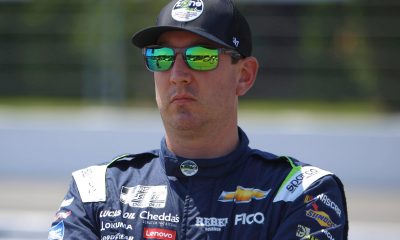
 Motorsports3 weeks ago
Motorsports3 weeks agoKyle Busch issues damning NASCAR statement after latest Cup Series blow


